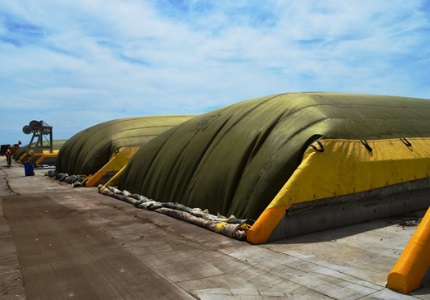Capacity Planning for Organic Waste Recycling
SB 1383 requires jurisdictions to implement mandatory organic waste collection and recycling in a statewide effort to divert organic waste from landfills. To help achieve this goal, the law requires jurisdictions to assess their current organics recycling capacity and plan to expand it if needed.
Jurisdictions are required to evaluate their capacity and plan to expand it if needed.
Counties are required to report capacity planning estimates to CalRecycle.
The reported estimates can be found on the SB 1383 Capacity Planning Data by County webpage.
Capacity Planning Requirements
California counties that provide solid waste collection services must plan for adequate capacity for recycling organic waste.
Each county is responsible for leading this collaborative effort among all cities, regional agencies, and special districts that provide solid waste collection services within the county.
Note: In the context of capacity planning, the term jurisdiction collectively refers to counties, cities, regional agencies, and special districts that provide solid waste collection services.
Each county is responsible for:
- Collecting organic waste recycling capacity information from jurisdictions.
- Identifying any jurisdiction that does not have enough capacity, including itself.
- Submitting an organic waste recycling capacity report to CalRecycle on the following schedule:
- By August 1, 2024, counties shall report on the period covering January 1, 2025, through December 31, 2034. (10-year period)
- By August 1, 2029, counties shall report on the period covering January 1, 2030, through December 31, 2039. (10-year period)
- By August 1, 2034, counties shall report on the period covering January 1, 2035, through December 31, 2044. (10-year period)
- Every five years starting in 2029
- Informing jurisdictions that have insufficient capacity that they must submit an implementation schedule to CalRecycle.
Each jurisdiction is responsible for:
- Estimating the amount of organic waste in tons that will be disposed of.
- Organic waste must include:
- Food scraps
- Landscape and pruning waste
- Wood
- Paper products
- Digestate and
- Biosolids.
- Organic waste must include:
- Identifying the amount of existing organic waste recycling infrastructure capacity, in tons:
- Located both in the county and outside of the county
- Verifiably available to the jurisdiction demonstrated by a:
-
- Contract
- Franchise agreement or
- Other documentation.
-
- A facility permit is not an indication of capacity available.
- Estimating the amount of new or expanded capacity needed to process the organic waste estimated to be disposed of.
- Responding to the county’s request for necessary capacity planning information within 120 days.

Exemptions with Department-Issued Waivers
Jurisdictions exempt from organic waste collection requirements are not required to include capacity plans (see Section 18992.3).
Waiver-exempt jurisdictions (see Section 18984.12), are not required to:
- Conduct the capacity planning required (see Section 18992.1)
- Include organic waste capacity planning data in the report submitted by the county if they continue to have a waiver.
A county is not required to obtain information from a waived jurisdiction and may subtract the waste generated in an area subject to a waiver for capacity planning purposes.
Low Population Waivers
Jurisdictions with a rural exemption or low population waiver were not required to conduct capacity planning for organic waste recycling.
- Jurisdictions will need to reassess whether they will be eligible for the low population waiver.
- If eligible, they should apply in late 2026 to be in place by Jan. 1, 2027.
- If not eligible, they must work with CalRecycle on plans to implement the organic waste collection requirements, which must start Jan. 1, 2027.
- Starting in 2027, jurisdictions without a waiver will be required to complete capacity planning on the scheduled timeline for the next 2029 capacity planning report.
The Final Statement of Reasons clarifies subsequent reporting periods. The laws state that exempt jurisdictions do not have to do capacity planning.
Implementation Schedule
Jurisdictions that have not identified enough existing or new organic waste recycling capacity must submit an implementation schedule to CalRecycle that must include timelines and milestones for planning capacity, including:
- Getting funding for organic waste recycling infrastructure, such as through modifying franchise agreements or other means of financially supporting the expansion of organic waste recycling.
- Identifying facilities, operations, and activities that could be expanded to recycle additional organic waste.


Capacity Planning is a Collaborative Effort
During the capacity planning process, the county, in coordination with jurisdictions and regional agencies, must work together to consult with the following entities:
Enforcement Agency and Local Task Force
This consultation provides the status and locations for new and expanding solid waste facilities, including potential capacity increases, and the planned closure of solid waste facilities.
Haulers and Owners of Facilities, Operations, and Activities that Recover Organic Waste
This consultation will help facilitate conversations between jurisdictions, haulers, and facilities to identify opportunities for securing feedstock agreements.
This will also help ensure that jurisdictions are receive information from businesses and other local entities that may control the operational infrastructure needed to recycle organic waste and sufficiently plan for additional infrastructure.
These entities must respond to the jurisdiction within 60 days.
Community Composting Operations
This consultation will help determine whether small-scale community composting operators may be able to recycle additional organic waste outside of conventional organic waste processing infrastructure.
This will also help ensure that jurisdictions involve local communities in their organic waste recycling capacity planning efforts.
Entities that are contacted by the county, city, regional agency, or special district that provide solid waste collection services must respond within 60 days. This will support counties and jurisdictions in meeting their capacity planning requirements within the regulatory timeframes.
Consulting with Communities
When considering the siting of new or expanded organics processing facilities, jurisdictions must conduct outreach to seek feedback on the possible benefits and impacts of the facilities on the surrounding communities. This includes ensuring that any affected disadvantaged communities are included in the community outreach. For more information about identifying disadvantaged communities, please see CalRecycle’s Environmental Justice page.
This will help facilitate feedback from the community during local planning process and help ensure that local communities are being consulted during capacity planning efforts.
Outreach requirements include:
- Reaching out to community members through public workshops or meetings, fliers, newspaper articles, email notices, and social media postings.
- Conducting outreach (when applicable) in coordination with potential solid waste facility operators that may use the site for organic waste recovery.
- Communicating in non-English languages spoken by a substantial number of the public.
Resources
- Organic Waste Recycling Capacity Planning Calculator. This web-based tool is intended to assist jurisdictions (including cities, unincorporated counties, regional agencies, and special districts) to plan for capacity needed to recycle organics materials as defined in the SB 1383 regulations. (See Section 18992.1(f)).
- Capacity Planning for Organic Waste Recycling Tools Webinar. CalRecycle hosted a webinar to cover the capacity planning tools designed to help jurisdictions comply with the capacity planning requirements. Use of the tools developed by the department is optional. YouTube (2021), English (02:03:33)
- PowerPoint Presentation.
- These guidance tools were developed by CalRecycle as a courtesy for informational and example purposes only. Use of these tools is optional and is not a regulatory requirement. In the event of any conflict with these guidance tools or information herein, applicable statutory and regulatory provisions shall control. These tools and information herein are based on known facts and legal authority as understood by CalRecycle at the time of release. Any analysis, guidance, or other information herein may be subject to change based on changed facts or legal authority, actual or understood, subsequent to the publishing of these tools. The provision of these guidance tools and any analysis, guidance, or other information herein shall not be construed as a waiver of any rights or remedies available to CalRecycle. Users are encouraged to seek the assistance of legal counsel to comply with applicable state law based on their pertinent facts and circumstances. CalRecycle makes no representation that use of these tools will ensure compliance with regulatory requirements. The user assumes all risk and CalRecycle accepts no responsibility or liability to any person because of the use of, or reliance upon, these tools or the information herein.
- San Diego County Capacity Planning
- SB 1383 Infrastructure and Market Analysis Report
- Collection FAQ
- Recycle Organics
For more information contact: Short-Lived Climate Pollutants (SLCP), Organic Waste Methane Emissions Reductions, SLCP.Organics@calrecycle.ca.gov
